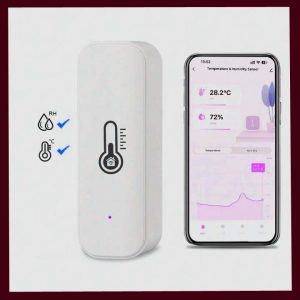

Ambient temperature sensor:
A mobile ambient temperature sensor is a device capable of measuring the temperature of the surrounding environment, typically designed for use with mobile devices such as smartphones or tablets. Here are some common features, advantages, and disadvantages of such sensors:
Here are some common features you might find in a mobile ambient temperature sensor:
- Compact Size:Users can easily carry mobile ambient temperature sensors around and use them in different locations because manufacturers design them to be small and portable.
- Accuracy: Accurate temperature measurement is crucial for many applications. High-quality sensors provide precise temperature readings within a narrow margin of error.
- Wide Temperature Range: The ability to measure a wide range of temperatures ensures versatility and suitability for various environments and applications.
- Fast Response Time: Quick response time enables users to get real-time temperature readings, making them useful for dynamic environments or rapid temperature changes.
- Durability: Mobile ambient temperature sensors are often used in outdoor or industrial environments where they may be exposed to harsh conditions. A durable construction ensures the sensor can withstand shocks, vibrations, moisture, and other environmental factors.
- Battery Life: Since mobile sensors are often battery-powered, long battery life is essential for extended use without frequent recharging or replacement.
- Wireless Connectivity: Some sensors come with Bluetooth, Wi-Fi, or other wireless connectivity options, allowing users to connect to smartphones, tablets, or other devices for data logging, remote monitoring, and analysis.
- Data Logging: Built-in data logging capabilities enable the sensor to store temperature readings over time, allowing users to track temperature trends and analyze data later.
- User Interface: Intuitive user interfaces, such as LCD displays or mobile apps, make it easy for users to read temperature measurements and configure sensor settings.
- Calibration: Some sensors may offer calibration options to ensure accuracy and consistency of temperature measurements, either through manual calibration or automatic self-calibration features.
- Alarm Functions: Alarm functions can alert users when temperature readings exceed predefined thresholds, helping to prevent damage or ensure safety in critical applications.
- Compatibility: Compatibility with various devices and platforms, such as smartphones, tablets, PCs, or IoT platforms, enhances the sensor’s usability and integration capabilities.
These features can vary depending on the specific model and manufacturer of the mobile ambient temperature sensor. Users should consider their specific requirements and use cases when choosing a sensor with the appropriate features.
Mobile ambient temperature sensors offer several advantages due to their portability, versatility, and ease of use. Here are some key advantages:
advantages:
- Portability: Perhaps the most significant advantage of mobile ambient temperature sensors is their portability. They are designed to be compact and lightweight, allowing users to carry them easily to various locations. This portability enables temperature monitoring in different environments, both indoors and outdoors, without the need for fixed installations.
- Versatility: Whether it’s for weather monitoring, HVAC system testing, industrial processes, automotive diagnostics, or consumer electronics, these sensors provide versatile temperature measurement solutions.
- Real-Time Monitoring: With mobile ambient temperature sensors, users can obtain real-time temperature readings wherever they go. This capability is particularly valuable in dynamic environments where temperature changes rapidly or in situations where immediate temperature data is necessary for decision-making.
- Convenience: These sensors offer a convenient way to monitor temperature without the need for complex installations or setups. Users can simply turn on the sensor, place it in the desired location, and start obtaining temperature readings immediately. This simplicity makes them accessible to a wide range of users, from professionals to hobbyists.
- Cost-Effectiveness: Mobile ambient temperature sensors can be a cost-effective solution compared to fixed or permanent temperature monitoring systems. They eliminate the need for expensive infrastructure or equipment installation, making them a more affordable option, especially for temporary or ad-hoc monitoring needs.
- Accessibility: With advancements in technology, mobile ambient temperature sensors often come with user-friendly interfaces, such as smartphone apps or intuitive displays, making temperature monitoring accessible to a broader range of users. This accessibility allows for greater democratization of temperature data collection and analysis.
- Remote Monitoring: Many mobile ambient temperature sensors come equipped with wireless connectivity options, such as Bluetooth or Wi-Fi, allowing for remote monitoring and data access. Users can connect to the sensor from their smartphones, tablets, or computers, enabling monitoring from a distance or across multiple locations.
- Data Logging and Analysis: These sensors often feature data logging capabilities, allowing users to store temperature readings over time for later analysis. This feature is particularly useful for tracking temperature trends, identifying patterns, and making informed decisions based on historical data.
Overall, the advantages of mobile ambient temperature sensors make them a valuable tool for various applications, offering flexibility, convenience, and reliable temperature monitoring capabilities in a portable form factor.
Disadvantages:
- Limited Range: Mobile ambient temperature sensors may have a limited temperature measurement range compared to dedicated temperature measurement devices.
- Accuracy Limitations: While modern sensors offer high accuracy, they may still have limitations compared to specialized temperature measurement equipment, particularly in extreme conditions or highly precise applications.
- Calibration Issues: Calibration of the sensor may drift over time or with environmental factors, potentially affecting the accuracy of temperature measurements.
- Environmental Interference: The temperature sensor in a mobile device may be susceptible to interference from other components or environmental factors, leading to inaccurate readings in some situations.
Overall, mobile ambient temperature sensors offer a convenient way for users to monitor temperature on the go, but they may have limitations in terms of accuracy and range compared to dedicated temperature measurement devices. Users should consider these factors when relying on such sensors for critical applications.
